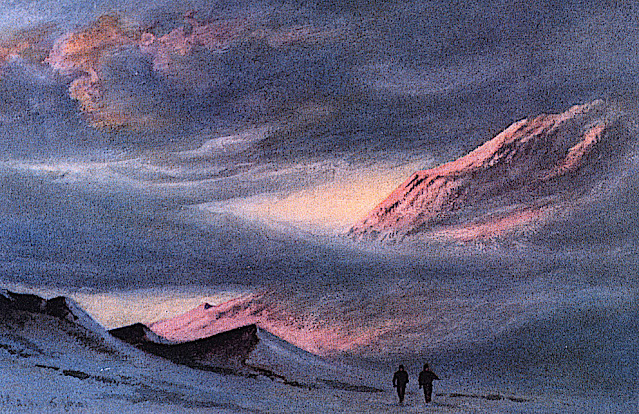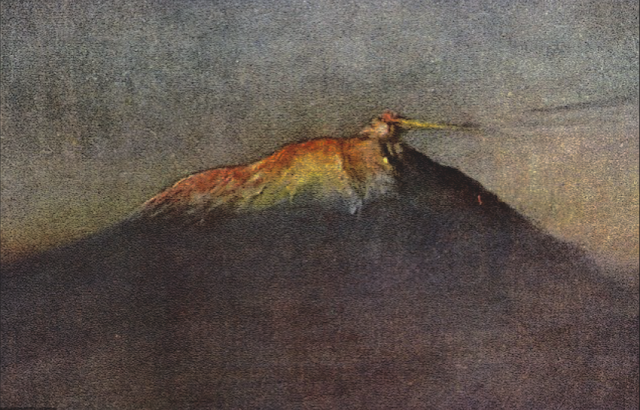HERBERT PONTING (1870-1935)
Mount Erebus (3, 794 m - 12, 448ft)
Antarctica (Ross Island)
In Mt. Erebus and a Dome Cloud, Scott Expedition, Antarctica 1911
The photographer
Herbert George Ponting, FRGS was a professional photographer. He is best known as the expedition photographer and cinematographer for Robert Falcon Scott's Terra Nova Expedition to the Ross Sea and South Pole (1910–1913). In this role, he captured some of the most enduring images of the Heroic Age of Antarctic Exploration.
As a member of the shore party in early 1911, Ponting helped set up the Terra Nova Expedition's Antarctic winter camp at Cape Evans, Ross Island. The camp included a tiny photographic darkroom. Although the expedition came more than 20 years after the invention of photographic film, Ponting preferred high-quality images taken on glass plates.
Ponting was one of the first men to use a portable movie camera in Antarctica. The primitive device, called a cinematograph, could take short video sequences. Ponting also brought some autochrome plates to Antarctica and took some of the first known color still photographs there.
The expedition's scientists studied the behavior of large Antarctic animals, especially killer whales, seals, and penguins. Ponting tried to get as close as possible to these animals, both on the Terra Nova in the sea ice and later on Ross Island, and narrowly escaped death on one occasion in early 1911 when a pod of eight killer whales broke up the ice floe in McMurdo Sound on which he was standing.
During the 1911 winter, Ponting took many flash photographs of Scott and the other members of the expedition in their Cape Evans hut. With the start of the 1911–12 sledging season, Ponting's field work began to come to an end. As a middle-aged man, he was not expected to help pull supplies southward over the Ross Ice Shelf for the push to the South Pole. Ponting photographed other members of the shore party setting off for what was expected to be a successful trek. After 14 months at Cape Evans, Ponting, along with eight other men, boarded the Terra Nova in February 1912 to return to civilization, arrange his inventory of more than 1,700 photographic plates, and shape a narrative of the expedition. Ponting's illustrated narrative would be waiting for Captain Scott to use for lectures and fundraising in 1913.
The catastrophic end of "Scott's Last Expedition" also affected Ponting's later life and career. When the Terra Nova had sailed south in 1910, it had left massive debts behind. It was expected that Scott would return from the South Pole as a celebrity and that he could use moving images from his expedition in a one-man show. Ponting's cinematograph sequences, pieced out with magic lantern slides, were to have been a key element in the expedition's financial payback.
However, when the bodies of Scott and his companions were discovered in their tent on the Ross Ice Shelf in November 1912, their diaries and journals were also found. These records described the explorers' final days while suffering from exposure and malnutrition, and their desperate effort to get to a depot of food and fuel that could have saved them. Scott knew he was doomed, and used his final hours to write pleas to his countrymen to look after the welfare of the expedition's widows and survivors.
The eloquent appeals, upon publication in the British press, wrung massive donations from the public. The gifts repaid the entire cost of the expedition, provided large annuities (carefully doled out by expedition status and rank) for the widows and survivors, and left a substantial surplus for eventual use as the startup endowment of the Scott Polar Research Institute (SPRI), an affiliate of Cambridge University.
Under these conditions, Ponting's Antarctic work took on a tragic overtone and became a memorial to Scott and his companions rather than a celebration. It was, however, used extensively in the press and exhibited at the Fine Art Society, Bond Street, shown in venues all over Britain and used in numerous lectures by Ponting and other expedition members (including at Buckingham Palace and the Royal Albert Hall). When World War I began Ponting tried, unsuccessfully, to persuade the War Office to make use of his skills as a photographer and war correspondent, but his age was cited as a reason for his being rejected for war service. Copies of his films of Scott were shown to soldiers at the front who were, according to an army chaplain, moved by the heroism of Scott and his men.
With the conclusion of the war, Ponting's archive drew a nibble of interest. He published The Great White South, the photographic narrative of the expedition, in 1921 which was a popular success, and produced two films based upon his surviving cinematograph sequences, The Great White Silence (1924 - silent) and Ninety Degrees South (1933 - sound). He also lectured extensively on the Antarctic. These works brought him little personal recompense but he continued to work on inventions related to the 'movies', including a special effects machine which was used in the English language version of "Emil and the Detectives" (1935). Ponting died in London in 1935; his photographs were sold to raise funds to pay for medical and other expenses.
The Scott Polar Research Institute purchased the Ponting Collection in 2004 for Ј533,000.
In 2009, SPRI and publisher Salto Ulbeek platinum-printed and published a selection of the Collection. The Great White Silence was restored by the British Film Institute and re-released in 2011. During the period of the Scott expedition centenary (2010-3) his work was widely published and exhibited, reaching new audiences.
In addition, one of Ponting's photographic darkrooms was reconstructed in the collections of the Ferrymead Heritage Park in Christchurch, New Zealand.
The mountain
Mount Erebus (3, 794 m - 12, 448ft), not to be confused with
Mount Elbrus is the second-highest volcano in Antarctica (after
Mount Sidley) and the southernmost active volcano on Earth. It is the sixth highest ultra mountain on an island, located on Ross Island, which is also home to three inactive volcanoes:
Mount Terror, Mount Bird, and Mount Terra Nova.
The volcano has been active since c. 1.3 million years ago and is the site of the Mount Erebus Volcano Observatory run by the New Mexico Institute of Mining and Technology.
Mount Erebus was discovered on January 27, 1841 (and observed to be in eruption) by polar explorer Sir James Clark Ross who named it and its companion, Mount Terror, after his ships, Erebus and Terror (which were later used by Sir John Franklin on his disastrous Arctic expedition). Erebus is a dark region in Hades in Greek mythology. Present with Ross on the Erebus was the young Joseph Hooker, future president of the Royal Society and close friend of Charles Darwin. Erebus was an Ancient Greek primordial deity of darkness, the son of Chaos.
The mountain was surveyed in December 1912 by a science party from Scott’s Terra Nova Expedition who also collected geological samples. Two of the camp sites they used have been recognised for their historic significance:
- Upper “Summit Camp” site (HSM 89) consists of part of a circle of rocks, which were probably used to weight the tent valances.
- Lower “Camp E” site (HSM 90) consists of a slightly elevated area of gravel as well as some aligned rocks, which may have been used to weight the tent valances.
They have been designated Historic Sites or Monuments following a proposal by the United Kingdom, New Zealand and the United States to the Antarctic Treaty Consultative Meeting.
Mount Erebus is classified as a polygenetic stratovolcano. The bottom half of the volcano is a shield and the top half is a stratocone. The composition of the current eruptive products of Erebus is anorthoclase-porphyritic tephritic phonolite and phonolite, which are the bulk of exposed lava flow on the volcano. Erebus is the world's only presently erupting phonolite volcano.
Researchers spent more than three months during the 2007–08 field season installing an unusually dense array of seismometers around Mount Erebus to listen to waves of energy generated by small, controlled blasts from explosives they buried along its flanks and perimeter and to record scattered seismic signals generated by lava lake eruptions and local ice quakes. By studying the refracted and scattered seismic waves, the scientists produced an image of the uppermost (top few km) of the volcano to understand the geometry of its "plumbing" and how the magma rises to the lava lake. These results demonstrated a complex upper-volcano conduit system with appreciable upper-volcano magma storage to the northwest of the lava lake at depths hundreds of meters below the surface.
Mount Erebus' summit crater rim was first achieved by members of Sir Ernest Shackleton's party; Professor Edgeworth David, Sir Douglas Mawson, Dr Alister Mackay, Jameson Adams, Dr Eric Marshall and Phillip Brocklehurst (who did not reach the summit), in 1908.
Its first known solo ascent and the first winter ascent was accomplished by British mountaineer Roger Mear on 7 June 1985, a member of the "In the Footsteps of Scott" expedition.
On January 19–20, 1991, Charles J. Blackmer, an iron-worker for many years at McMurdo Station and the South Pole, accomplished a solo ascent in approximately seventeen hours completely unassisted via snow mobile and on foot.
In 1992 the inside of the volcano was explored by Dante I, an eight legged tethered robotic explorer. Dante was designed to acquire gas samples from the magma lake inside the inner crater of Mount Erebus. Unfortunately, Dante I had not yet reached the bottom of the crater and so no data of volcanic significance was recorded.

















